Page 333 of 542
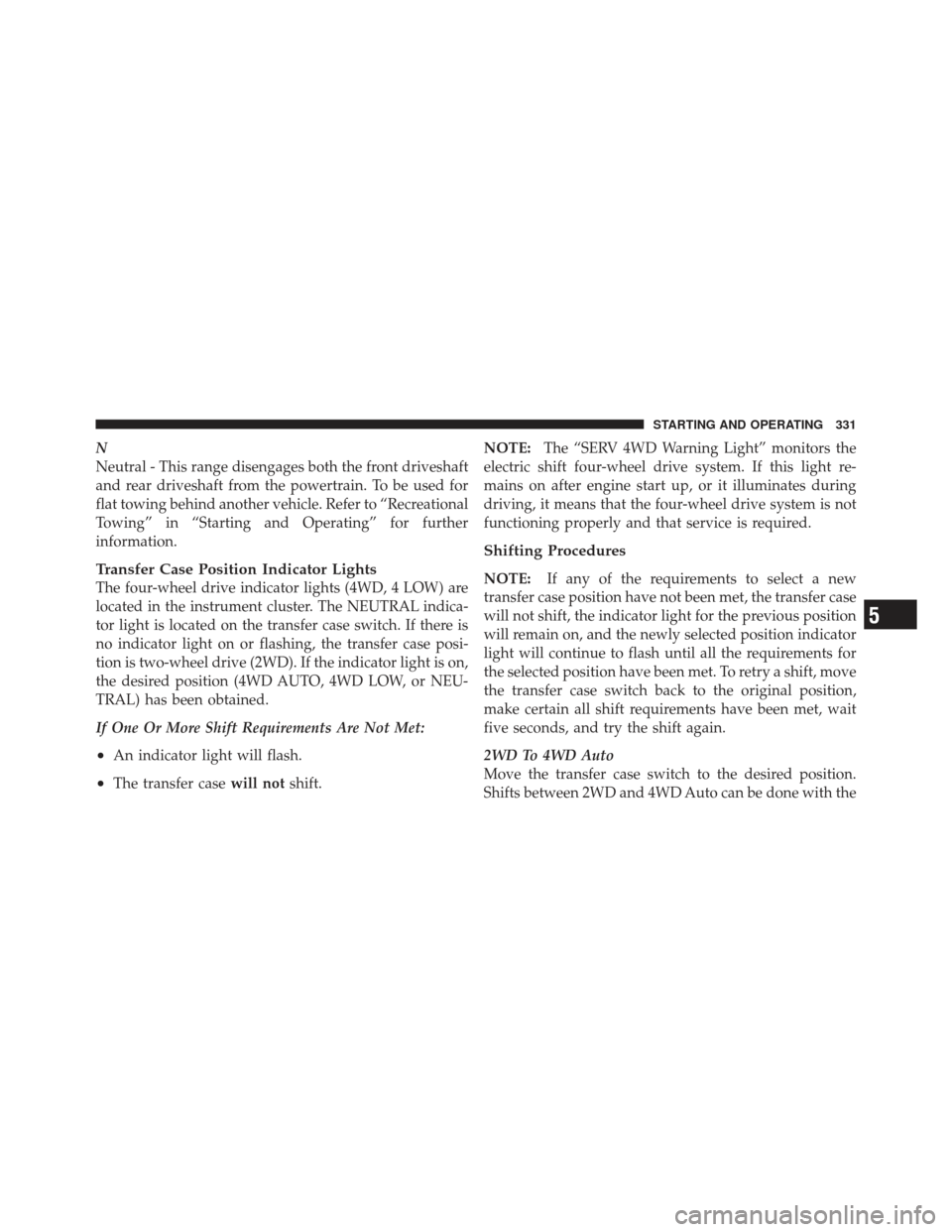
N
Neutral - This range disengages both the front driveshaft
and rear driveshaft from the powertrain. To be used for
flat towing behind another vehicle. Refer to “Recreational
Towing” in “Starting and Operating” for further
information.
Transfer Case Position Indicator Lights
The four-wheel drive indicator lights (4WD, 4 LOW) are
located in the instrument cluster. The NEUTRAL indica-
tor light is located on the transfer case switch. If there is
no indicator light on or flashing, the transfer case posi-
tion is two-wheel drive (2WD). If the indicator light is on,
the desired position (4WD AUTO, 4WD LOW, or NEU-
TRAL) has been obtained.
If One Or More Shift Requirements Are Not Met:
•An indicator light will flash.
•The transfer casewill notshift. NOTE:
The “SERV 4WD Warning Light” monitors the
electric shift four-wheel drive system. If this light re-
mains on after engine start up, or it illuminates during
driving, it means that the four-wheel drive system is not
functioning properly and that service is required.
Shifting Procedures
NOTE: If any of the requirements to select a new
transfer case position have not been met, the transfer case
will not shift, the indicator light for the previous position
will remain on, and the newly selected position indicator
light will continue to flash until all the requirements for
the selected position have been met. To retry a shift, move
the transfer case switch back to the original position,
make certain all shift requirements have been met, wait
five seconds, and try the shift again.
2WD To 4WD Auto
Move the transfer case switch to the desired position.
Shifts between 2WD and 4WD Auto can be done with the
5
STARTING AND OPERATING 331
Page 335 of 542
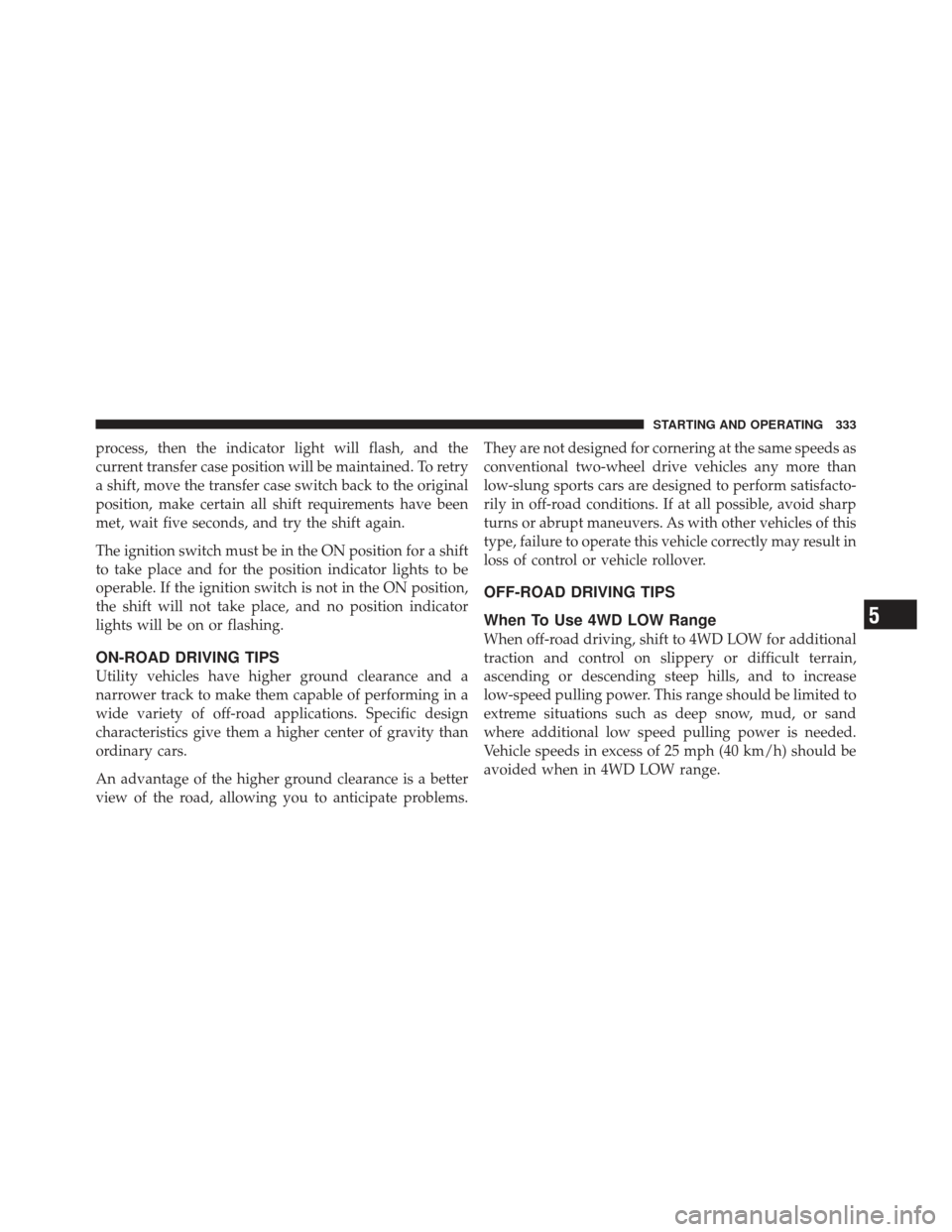
process, then the indicator light will flash, and the
current transfer case position will be maintained. To retry
a shift, move the transfer case switch back to the original
position, make certain all shift requirements have been
met, wait five seconds, and try the shift again.
The ignition switch must be in the ON position for a shift
to take place and for the position indicator lights to be
operable. If the ignition switch is not in the ON position,
the shift will not take place, and no position indicator
lights will be on or flashing.
ON-ROAD DRIVING TIPS
Utility vehicles have higher ground clearance and a
narrower track to make them capable of performing in a
wide variety of off-road applications. Specific design
characteristics give them a higher center of gravity than
ordinary cars.
An advantage of the higher ground clearance is a better
view of the road, allowing you to anticipate problems.They are not designed for cornering at the same speeds as
conventional two-wheel drive vehicles any more than
low-slung sports cars are designed to perform satisfacto-
rily in off-road conditions. If at all possible, avoid sharp
turns or abrupt maneuvers. As with other vehicles of this
type, failure to operate this vehicle correctly may result in
loss of control or vehicle rollover.
OFF-ROAD DRIVING TIPS
When To Use 4WD LOW Range
When off-road driving, shift to 4WD LOW for additional
traction and control on slippery or difficult terrain,
ascending or descending steep hills, and to increase
low-speed pulling power. This range should be limited to
extreme situations such as deep snow, mud, or sand
where additional low speed pulling power is needed.
Vehicle speeds in excess of 25 mph (40 km/h) should be
avoided when in 4WD LOW range.
5
STARTING AND OPERATING 333
Page 411 of 542
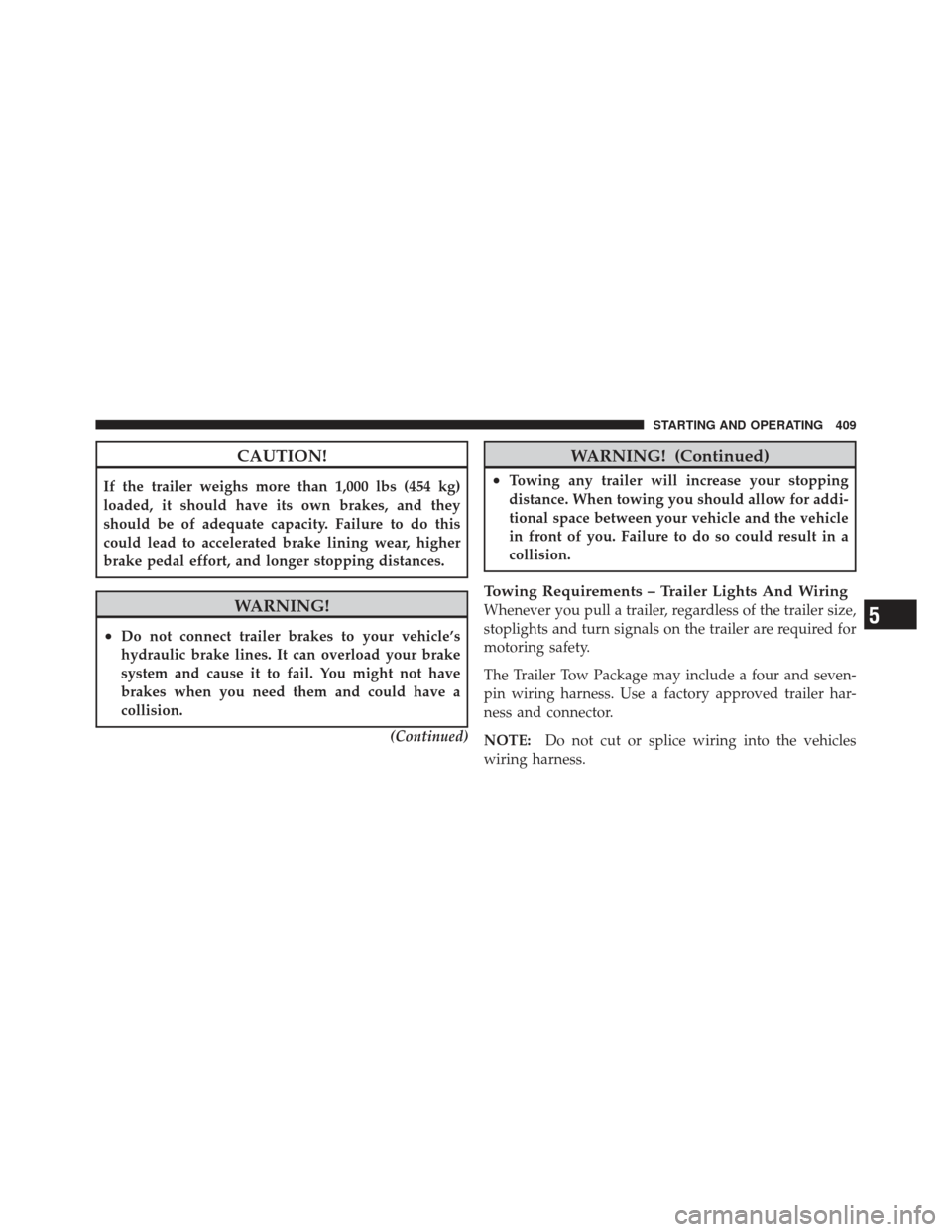
CAUTION!
If the trailer weighs more than 1,000 lbs (454 kg)
loaded, it should have its own brakes, and they
should be of adequate capacity. Failure to do this
could lead to accelerated brake lining wear, higher
brake pedal effort, and longer stopping distances.
WARNING!
•Do not connect trailer brakes to your vehicle’s
hydraulic brake lines. It can overload your brake
system and cause it to fail. You might not have
brakes when you need them and could have a
collision.(Continued)
WARNING! (Continued)
•Towing any trailer will increase your stopping
distance. When towing you should allow for addi-
tional space between your vehicle and the vehicle
in front of you. Failure to do so could result in a
collision.
Towing Requirements – Trailer Lights And Wiring
Whenever you pull a trailer, regardless of the trailer size,
stoplights and turn signals on the trailer are required for
motoring safety.
The Trailer Tow Package may include a four and seven-
pin wiring harness. Use a factory approved trailer har-
ness and connector.
NOTE:Do not cut or splice wiring into the vehicles
wiring harness.5
STARTING AND OPERATING 409
Page 420 of 542
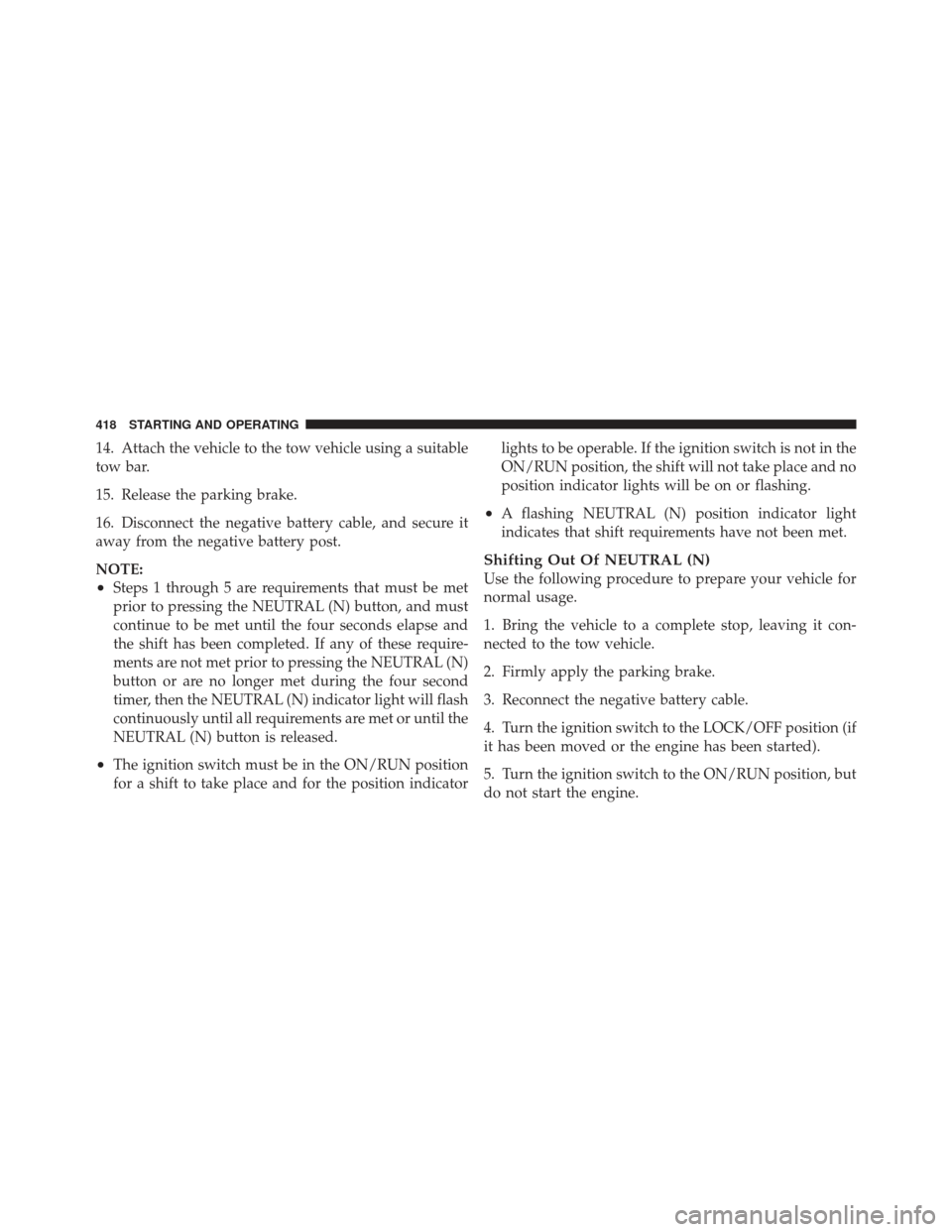
14. Attach the vehicle to the tow vehicle using a suitable
tow bar.
15. Release the parking brake.
16. Disconnect the negative battery cable, and secure it
away from the negative battery post.
NOTE:
•Steps 1 through 5 are requirements that must be met
prior to pressing the NEUTRAL (N) button, and must
continue to be met until the four seconds elapse and
the shift has been completed. If any of these require-
ments are not met prior to pressing the NEUTRAL (N)
button or are no longer met during the four second
timer, then the NEUTRAL (N) indicator light will flash
continuously until all requirements are met or until the
NEUTRAL (N) button is released.
•The ignition switch must be in the ON/RUN position
for a shift to take place and for the position indicatorlights to be operable. If the ignition switch is not in the
ON/RUN position, the shift will not take place and no
position indicator lights will be on or flashing.
•A flashing NEUTRAL (N) position indicator light
indicates that shift requirements have not been met.
Shifting Out Of NEUTRAL (N)
Use the following procedure to prepare your vehicle for
normal usage.
1. Bring the vehicle to a complete stop, leaving it con-
nected to the tow vehicle.
2. Firmly apply the parking brake.
3. Reconnect the negative battery cable.
4. Turn the ignition switch to the LOCK/OFF position (if
it has been moved or the engine has been started).
5. Turn the ignition switch to the ON/RUN position, but
do not start the engine.
418 STARTING AND OPERATING
Page 422 of 542
17. Shift the transmission into DRIVE, release the brake
pedal, and check that the vehicle operates normally.
NOTE:
•Steps 1 through 7 are requirements that must be met
prior to pressing the NEUTRAL (Neutral) button, and
must continue to be met until the shift has been
completed. If any of these requirements are not met
prior to pressing the NEUTRAL (N) button or are no
longer met during the shift, the NEUTRAL (N) indi-
cator light will flash continuously until all require-
ments are met or until the NEUTRAL (N) button is
released.
•The ignition switch must be in the ON/RUN position
for a shift to take place and for the position indicator
lights to be operable. If the ignition switch is not in the
ON/RUN position, the shift will not take place and no
position indicator lights will be on or flashing.
•A flashing NEUTRAL (N) position indicator light
indicates that shift requirements have not been met.
420 STARTING AND OPERATING
Page 478 of 542
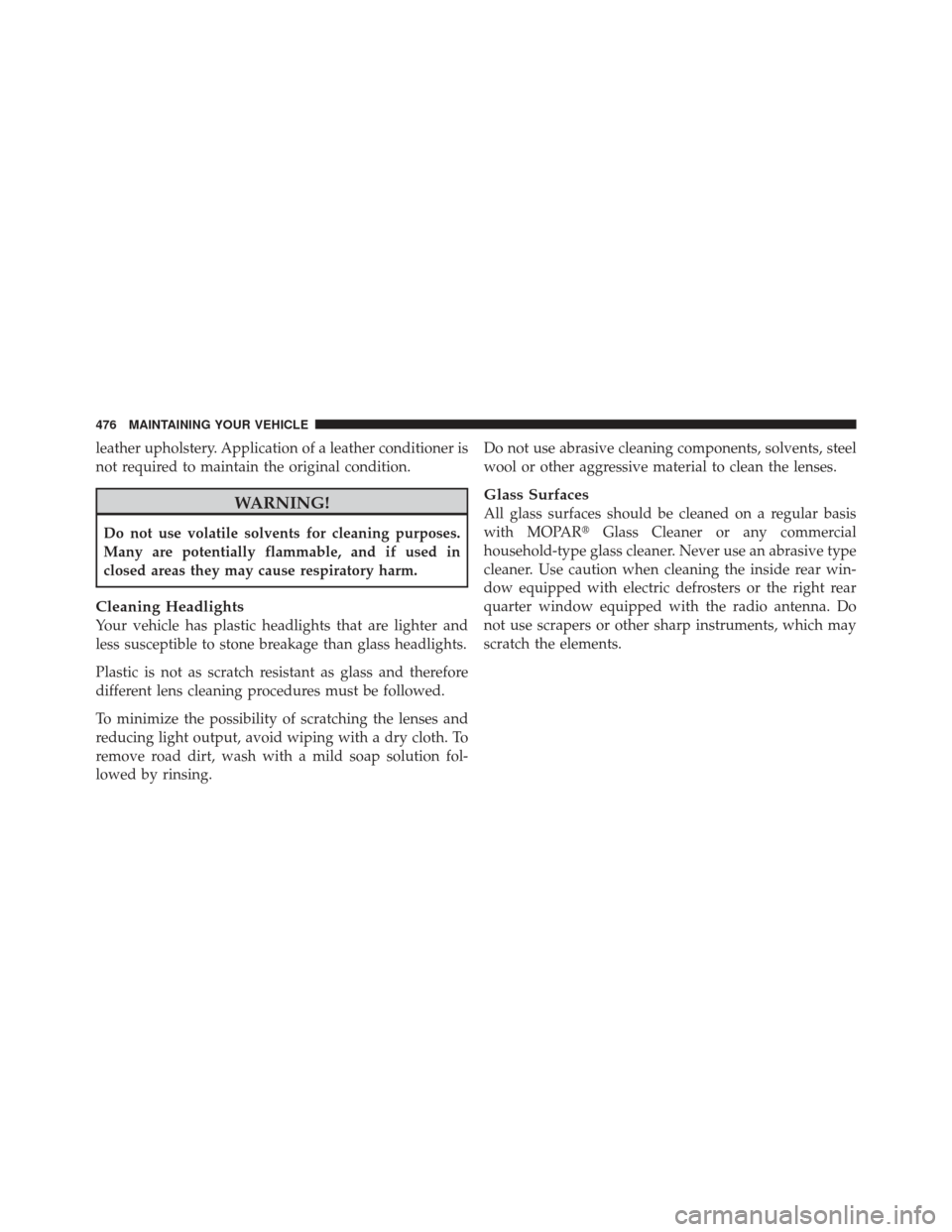
leather upholstery. Application of a leather conditioner is
not required to maintain the original condition.
WARNING!
Do not use volatile solvents for cleaning purposes.
Many are potentially flammable, and if used in
closed areas they may cause respiratory harm.
Cleaning Headlights
Your vehicle has plastic headlights that are lighter and
less susceptible to stone breakage than glass headlights.
Plastic is not as scratch resistant as glass and therefore
different lens cleaning procedures must be followed.
To minimize the possibility of scratching the lenses and
reducing light output, avoid wiping with a dry cloth. To
remove road dirt, wash with a mild soap solution fol-
lowed by rinsing.Do not use abrasive cleaning components, solvents, steel
wool or other aggressive material to clean the lenses.
Glass Surfaces
All glass surfaces should be cleaned on a regular basis
with MOPAR�
Glass Cleaner or any commercial
household-type glass cleaner. Never use an abrasive type
cleaner. Use caution when cleaning the inside rear win-
dow equipped with electric defrosters or the right rear
quarter window equipped with the radio antenna. Do
not use scrapers or other sharp instruments, which may
scratch the elements.
476 MAINTAINING YOUR VEHICLE
Page 483 of 542
Cavity CartridgeFuseMini-
Fuse Description
M16 — 10 Amp RedAirbag Module
M17 — 15 Amp BlueExterior Lighting – Left
Front Park and Side
Marker, Left Tail and
Running, License
Lights
M18 — 15 Amp BlueExterior Lighting –
Right Front Park and
Side Marker, Right Tail
and Running Lights
M19 — 25 Amp NaturalAutomatic Shutdown
#1 and #2Cavity Cartridge
FuseMini-
Fuse Description
M20 — 15 Amp BlueInterior Lighting/
Steering Wheel
Switches – If
Equipped/Switch
Bank/Steering Column
Module – If Equipped
M21 — 20 Amp YellowAutomatic Shutdown
#3
M22 — 10 Amp RedRight Horn (Hi/Low)
M23 — 10 Amp RedLeft Horn (Hi/Low)
M24 — 25 Amp NaturalRear Wiper – If
Equipped
M25 — 20 Amp YellowFuel Pump, Diesel Lift
Pump – If Equipped
7
MAINTAINING YOUR VEHICLE 481
Page 484 of 542
Cavity CartridgeFuseMini-
Fuse Description
M26 — 10 Amp RedPower Mirror Switch/
Driver Window Switch
M27 — 10 Amp RedIgnition Switch/
Wireless Control
Module/Steering Col-
umn Lock – If
Equipped
M28 — 10 Amp RedPowertrain Control
Module
M29 — 10 Amp RedOccupant Classification
Module
M30 — 15 Amp BlueRear Wiper Module –
If Equipped/Power
Folding Mirror – If
Equipped/Diagnostic
LinkCavity Cartridge
FuseMini-
Fuse Description
M31 — 20 Amp YellowBack-Up Lights
M32 — 10 Amp RedAirbag Module
M33 — 10 Amp RedPowertrain Control
Module
M34 — 10 Amp RedPark Assist Module – If
Equipped/Climate
Control System Mod-
ule – If Equipped/
Compass Module – If
Equipped/Cabin
Heater – If Equipped/
Diesel Rad Fan – If
Equipped
M35 — 10 Amp RedHeated Mirrors – If
Equipped
482 MAINTAINING YOUR VEHICLE